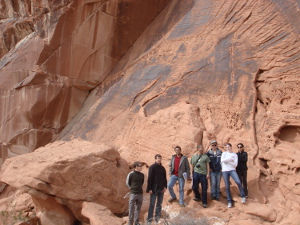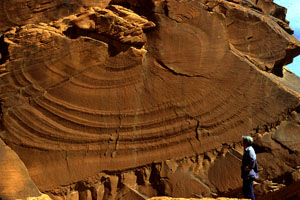| |||||||
|
|
|||||||
|
|
|||||||
| Fringe Joints | |||||||
|
Fringe joints occur at the borders of joints as extensions of twisted and rotated hackle marks from their initially planar parent joints (Pollard and Aydin, 1988). They diverge gradually usually by a small angle of 5-25° from the planar faces of the parent joints (Figure 1), but larger angles with sharp divergence are also observed (Figure 2). In cross section view fringe joints appear to be echelon indicating mode I-III propagation. Fringe joints described in the geological literature only occur in relatively small areas with respect to the whole planar parent joint surfaces. However, if the fringe joints are extended well beyond the parent joints, then the relationship between the parent joints and the new system of joints isn't readily apparent. Perhaps that is why the word 'fringe' has not been used for these latter cases. | |||||||
| Reference: |
|||||||
| Aydin, A., Borja, R., Eichhubl, P., 2006 Pollard, D.D., Aydin, A., 1988 |
|||||||
|
Readme | About Us | Acknowledgement | How to Cite | Terms of Use | Ⓒ Rock Fracture Knowledgebase |
|||||||

